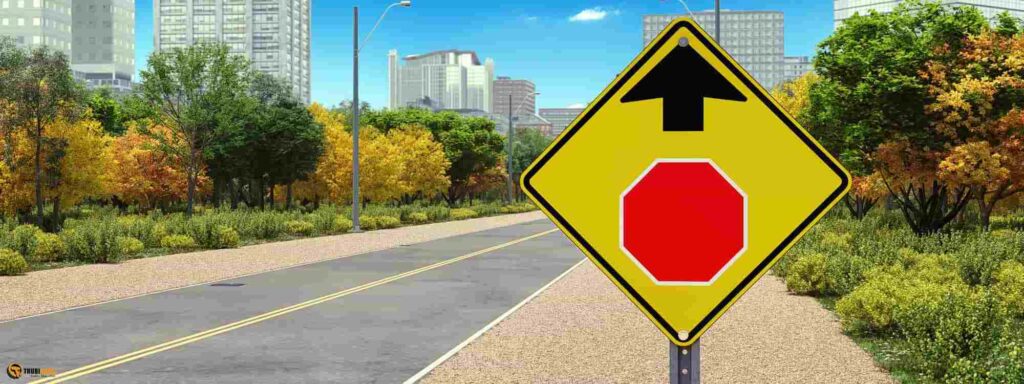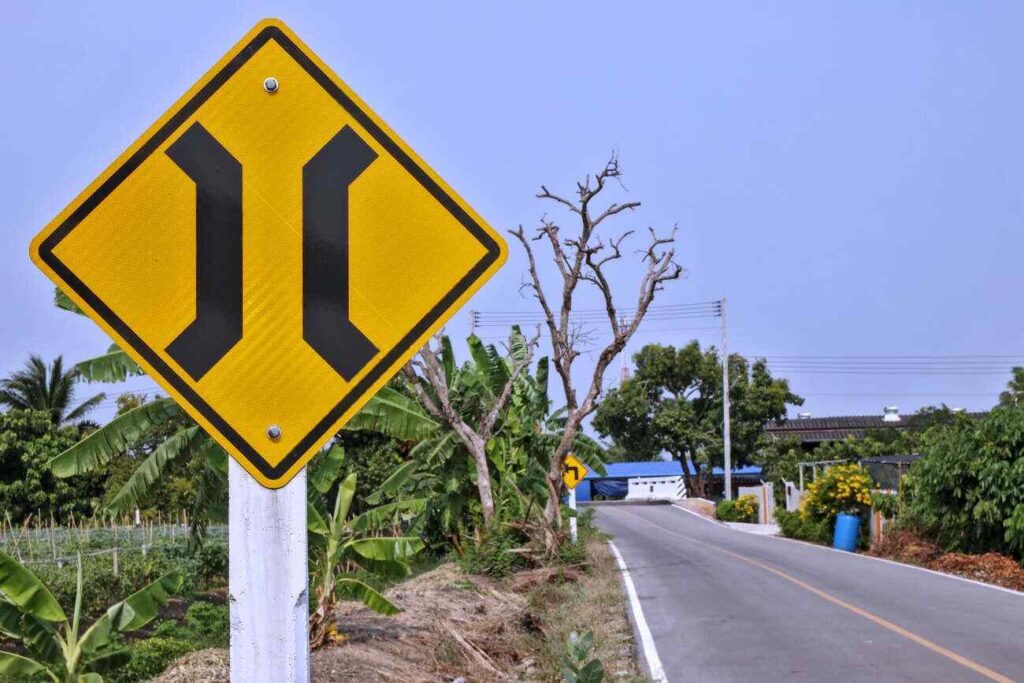The stop sign ahead sign plays a key role in road safety. It warns drivers that a stop sign is coming up. This gives them time to slow down and prepare to stop. In busy areas or places with poor visibility, this sign can prevent accidents. Many drivers see it every day, but few think about its details. This post covers everything from its design to how it works in different places. By the end, you will understand why this sign matters and how to use it right.
What Is the Stop Sign Ahead Sign?
The stop sign ahead sign is a warning sign on roads. It tells drivers a stop sign is further along the path. In the United States, it follows rules set by the Manual on Uniform Traffic Control Devices, or MUTCD. This manual sets standards for all road signs to keep things consistent.
The sign is often yellow with black letters or symbols. It can say “STOP AHEAD” in words or show a picture of a stop sign. The symbol version uses a red octagon shape inside the yellow diamond. This makes it easy to spot from far away. Drivers know to get ready for a full stop soon.
You might see this sign before intersections where the stop sign is hard to see right away. For example, if trees or buildings block the view, the warning helps. It also appears on roads with high speeds, where stopping suddenly could be dangerous. Without it, drivers might not slow down in time, leading to crashes.
In some cases, the sign includes extra features like flashing lights. These are for areas with more risk, such as near schools or sharp turns. The basic idea stays the same: alert drivers to the upcoming stop.
History of the Stop Sign Ahead Sign
The story of the stop sign ahead sign ties into the growth of road signs in general. Road signs started in the early 1900s as cars became common. The first stop sign showed up in Detroit, Michigan, in 1915. It was a square with black letters on white, nothing like today’s red octagon.
As traffic grew, the need for warnings increased. By the 1920s, groups worked on standard signs. The American Association of State Highway Officials helped create early guidelines. They saw that drivers needed advance notice for stops, especially on faster roads.
The MUTCD first came out in 1935. It included warning signs like the one for stops ahead. Over time, the design changed to yellow diamonds for warnings. This shape and color stood out better than older versions.
In the 1950s, reflective materials improved signs for night use. The stop sign ahead sign got these updates too. By the 1970s, symbols replaced words in many cases to help non-English speakers.
Changes continued with each MUTCD update. The 2009 edition set clear rules for the W3-1 sign, which is the code for stop ahead. Today, it’s part of a system that has saved many lives by giving drivers more time to react.
The sign has adapted to new tech too. Some now use solar-powered lights for better visibility in bad weather. This history shows how road safety has improved step by step.
Design and Specifications of the Stop Sign Ahead Sign
The design of the stop sign ahead sign follows strict rules. It’s a diamond shape, which means warning in the US system. The background is yellow, and the border and letters are black. This color combo grabs attention fast.
Sizes vary by road type. On regular roads, it’s often 30 inches by 30 inches. For highways, it can be 48 inches by 48 inches. Bigger signs help on faster roads where drivers need to see them from farther away.
The sign can use words or a symbol. The word version says “STOP AHEAD” in big, bold letters. The symbol shows a small red stop sign inside. Both are clear, but symbols work better for quick glances.
Materials matter for durability. Most use aluminum with reflective sheeting. This makes the sign shine when headlights hit it at night. The MUTCD requires this for all warning signs.
In some spots, the sign might have a plaque below with distance, like “200 FT.” This adds precision. Flashing beacons can attach to it for extra warning in high-risk areas.
These specs ensure the sign does its job well. They come from years of testing to find what works best for drivers.
Purpose and Importance of the Stop Sign Ahead Sign
The main purpose of the stop sign ahead sign is to warn drivers of a stop coming up. This is key when the actual stop sign isn’t visible early. It gives time to slow down safely.
Safety is the big reason it’s important. Without warning, drivers might speed into an intersection. This raises crash risks, especially at blind spots or hills. The sign cuts down on sudden stops, which can cause rear-end accidents.
It also helps in bad weather. Rain, fog, or snow can hide stop signs. The advance warning stands out more and prepares drivers better.
For new drivers or visitors, the sign clarifies road rules. It reminds everyone to check for traffic before proceeding. In rural areas with few signs, it prevents surprises.
Studies show these warnings lower accident rates. They make roads predictable, which is vital for smooth traffic flow. Ignoring the sign can lead to tickets or worse.
In short, this sign saves lives by promoting careful driving. It’s a simple tool with a big impact on road safety.
Placement Guidelines for the Stop Sign Ahead Sign
Where to put the stop sign ahead sign is based on engineering rules. The MUTCD gives tables for distances. These depend on speed limits.
For a 30 mph road, place it about 100 feet before the stop sign. At 50 mph, it might be 350 feet or more. This gives drivers time to react.
Height matters too. The bottom should be at least 7 feet above the ground on rural roads, 5 feet in cities. This keeps it visible over cars or bushes.
It goes on the right side of the road, facing traffic. If the road has multiple lanes, another might go on the left.
Engineers check the site first. They look for visibility issues like curves or trees. If needed, they adjust placement.
In work zones, temporary versions might appear. These follow similar rules but can move as needed.
Proper placement makes the sign effective. Wrong spots could confuse drivers or go unnoticed.
Legal Aspects of the Stop Sign Ahead Sign
The stop sign ahead sign isn’t just a suggestion; it ties into traffic laws. States follow MUTCD standards, making it a legal requirement in many places.
Drivers must heed warnings like this. Failing to slow down could count as reckless driving if an accident happens. Courts might use it as evidence in cases.
Local governments decide where to install them based on studies. They must maintain them to avoid liability.
If a sign is missing or damaged, it could affect fault in crashes. Drivers still need to drive carefully, but poor signs might shift blame.
In some states, ignoring advance warnings leads to higher fines. For example, speeding through a warned area might double penalties.
Understanding these legal sides helps drivers stay safe and avoid trouble. It’s part of following road rules everywhere.
Effectiveness and Studies on the Stop Sign Ahead Sign
Research looks at how well the stop sign ahead sign works. One study checked pavement markings with “STOP AHEAD” words. It found they help more than signs alone in some cases.
Another report gave crash reduction factors. Adding the marking cut crashes by certain amounts at test sites.
Beacons on signs also show promise. A study saw fewer crashes with flashing lights on stop ahead signs.
Eye-tracking tests measured driver reactions. Signs made drivers scan better and brake sooner.
Not all studies agree on perfect results. Some say signs lose effect if overused. Drivers might ignore them in familiar areas.
Overall, data supports using them. They lower speeds and improve stops at intersections. More research helps refine their use.
International Variations of the Stop Sign Ahead Sign
The stop sign ahead sign changes across countries. In the US, it’s a yellow diamond with words or symbol.
In Europe, many use a triangle for warnings. The sign might show a stop symbol inside a red triangle. Countries like France or Germany follow Vienna Convention rules for consistency.
Canada uses similar designs to the US, but with French text in Quebec. It’s still yellow and diamond-shaped.
In the UK, it’s a blank give way sign with “STOP” and distance. This warns of a stop ahead.
Australia has yellow diamonds too, close to US style. But words might differ slightly.
In Asia, Japan uses triangles with Japanese text or symbols. Stop signs say “Tomare,” but warnings are pictorial.
These differences come from local standards. Yet, most aim for the same goal: warn of stops. Travelers should learn local signs to stay safe.
Colors often stay yellow or red for warnings worldwide. Shapes like diamonds or triangles signal caution. This helps even without reading the language.
Common Mistakes Drivers Make with the Stop Sign Ahead Sign
Drivers sometimes mishandle the stop sign ahead sign. One error is ignoring it and not slowing down. This leads to hard stops or running the actual stop sign.
Another mistake is creeping past the stop line if visibility is poor. You must stop first, then move if needed.
Some think the warning means yield, not full stop. But it just alerts to the coming stop sign.
In bad weather, drivers might miss the sign if not paying attention. This raises risks.
New drivers often forget to check cross traffic after seeing the warning. The sign is a prep, not the end.
Misreading distance plaques happens too. If it says “500 FT,” don’t wait too long to brake.
Avoiding these errors keeps everyone safe. Always treat the sign as a serious alert.
Maintenance of the Stop Sign Ahead Sign
Keeping the stop sign ahead sign in good shape is crucial. Road crews check them regularly for damage or fading.
Clean signs reflect better at night. Dirt or graffiti can hide the message.
Replace bent or broken ones fast. Weather like wind or snow can harm them.
In construction areas, temporary signs need checks too.
Vegetation around signs gets trimmed. Bushes can block views.
Reflective testing ensures they shine enough. Old sheeting loses brightness over time.
Proper maintenance prevents accidents from poor visibility. It’s part of keeping roads safe.
Related Signs to the Stop Sign Ahead Sign
The stop sign ahead sign is one of many warnings. The yield ahead sign looks similar but for yield signs. It’s W3-2 in MUTCD.
Signal ahead warns of traffic lights. It’s W3-3, yellow diamond with light symbol.
Be prepared to stop is W3-4, used in work zones or temporary spots.
Intersection warnings show crossing roads ahead. These help at complex junctions.
All these share the yellow diamond shape. They work together for better traffic control.
Knowing them helps drivers respond right to different situations.
For more information visit Traffic signs test.
Conclusion
The stop sign ahead sign is a simple but powerful tool for road safety. It warns of stops, giving time to prepare. From its history to design, every part aims to protect drivers.
By following guidelines and avoiding mistakes, you can use it well. Maintenance keeps it working, and understanding variations helps abroad.
Next time you see one, remember its role. Safe driving starts with paying attention to signs like this. Stay alert, and roads become safer for all.


